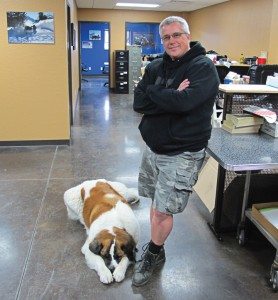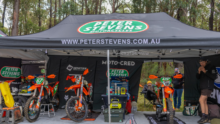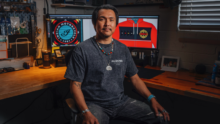On the gas with snowmobile accessories
Skinz fights off slow economy with innovation
Compared to the fat times of the late 1990s and early 2000s, things aren’t quite so plump in the snowmobile industry these days as tighter credit, gas and oil prices, stricter emissions requirements and more expensive machines have conspired to shrink annual U.S. sales to less than 49,000 units. That’s down from a high of 170,000 units at the industry’s most recent peak in 1997, with very healthy years continuing through much of the 2000s.
But don’t tell that sad story to Jeff and Tammy Hawksworth, owners of Skinz Protective Gear, who are steering their snowmobile aftermarket shop through an unprecedented growth streak that has required adding employees, manufacturing new products and building a new facility or adding on to existing facilities for each of the past seven years in their rural base in central Minnesota.
Former mountain bike enthusiasts from Phoenix, the Hawksworths started making kneepads and elbow pads, among other accessories, for similarly aggressive bike riders, but shifted their focus toward the snowmobile market seven years ago after the consumer magazine (and Powersports Business sister publication) Snow Goer awarded Skinz for its innovative waterproof, stretchy snowmobile cover.
From that point forward, it’s been full speed ahead. Skinz has quickly grown into a force both in tiny Paynesville, population 2,443, as well as the international snowmobile aftermarket business as a whole.
Difficult beginnings
Originally lured to Minnesota farm country to work at a family business, a falling out meant the Hawksworths were on their own in unfamiliar territory. With no jobs and tight finances, the couple engaged in some soul searching and decided to stay put in Paynesville. They quickly got to work building bike and snowmobile accessories.
Not quite a decade on, Skinz Protective Gear has grown dramatically with a product mix that is currently 80 percent snowmobile, 15 percent bicycle and 5 percent other things — mostly unrelated contract work to diversify the company’s portfolio. As it has pushed into the snowmobile market, Skinz has discovered tremendous success that the owners say could be even better without difficulty finding skilled labor in such a rural area.
“People look at the powersports business and see things falling, but for us in the powersports business, we have grown as fast as we can grow,” Jeff Hawksworth said. “We could’ve been twice the size that we are today if we could’ve found [more] workers four years ago.”
After humble beginnings, the company now builds a wide range of accessories that is far beyond the original line of protective gear, storage bags and stretchy wraps.
On its snowmobile side, Skinz sells ultra-light seat kits, headlight delete kits, chip-blocking A-arm guards, ice-reducing tunnel films, specialized steering posts, high-tech running boards, high-end side panels, brightly colored ski guards, high-performance silencers and flotation-enhancing front skid plates, among many others.
While it’s a small part of the overall product mix, Skinz also markets cold-weather bicycle apparel, innovative bike stands, hydration backpacks, helmet and shoe bags and its traditional storage bags, designed to protect high-end bikes from damage while traveling between destinations.
At the top end of the Skinz product line, the company sells fully equipped, highly modified Yamaha FX Nytro snowmobiles for the mountain-riding crowd, a growing segment. Called the Black concept snowmobiles, Skinz strips Nytros down to the skeleton and builds them back up with unique and aggressive front suspensions, more aggressive tracks, under-tunnel exhaust, custom seat, tunnel and running boards, Timbersled rear suspensions and many other modifications.
The high-end snowmobiles start at $19,999 (including the Yamaha Nytro), although customers can also bring their existing Nytros to Skinz to be modified for a lower price. Hawksworth said the company has built 10-15 full Nytro Blacks this year, and has done at least that many conversion projects.
Growing Paynes
Rather than outsourcing its production abroad to keep up with ravenous demand that continues to outstrip capacity, Skinz has elected to keep all of its manufacturing in-house, aside from some contracted sewing done in their home state of Arizona.
“We do it here because of the quality, and I don’t care what the cost is,” Hawksworth said. “Part of our ideology is 100 percent American made, because we want the control over what we’re building and that’s just a huge part for us.”

While Skinz has occasionally struggled to find quality workers near its rural headquarters, and Hawksworth feels extended federal unemployment benefits only exacerbate the trouble, Skinz has grown to its current headcount of 20 employees. That number includes three newly hired TIG welders.
Most of the company’s action takes place inside a two-year-old, 25,000 square-foot building with manufacturing and offices. Two new CNC machines were delivered after the first of the year, and a massive addition will double the building’s space, scheduled to get underway before the spring thaw. The new building was originally intended to last three years. In that same time period, Skinz has also purchased a compound of preexisting buildings near downtown Paynesville, with 12,500 square feet to be used as a research and development space.
“We were here a year and already knew that we were going to be out of space, so we hurried up and got [the new] slab poured and the building is going up at the end of February,” he said.
When asked how he’s had such explosive growth during a period of time that included the greatest economic downturn since the Great Depression, Hawksworth points to the enduring popularity and advancement of the snowmobile industry, quality aftermarket products, investing heavily into the business and working very long days that often start before 7 a.m. and extend beyond midnight.
Another growth-enabling factor has been Small Business Administration loans and local assistance from the city of Paynesville that has facilitated previous expansions and enabled Skinz to become a large employment force in the area.
“We’ve had a great relationship with Paynesville,” Hawksworth said. “They’ve always told us they have some money at really low interest rates, so if you guys expand, come and talk to us — so that’s what we did.”
Staying independent
While Skinz products are sold through many dealerships and national distributors, the company maintains the importance of selling directly to customers. Hawksworth said the advantages for remaining independent include hands-on customer service, less hassles and — in the case of last year’s busy snowmobile season — being able to shut down its own website to give the factory time to meet demand.
While a vital part of the business, Hawksworth said it’s challenging to convince distributors to carry the right products in proper quantities.
“We’ve tried to work with our distributors and say, ‘You’ve got to commit to this, that’s your job as a distributor,’ but they won’t do it,” he said. “Then, when you finally do get them to commit to something, then it won’t sell and then the whole thing just goes down the tubes.”
As far as its future, Hawksworth is interested in exploring the motocross dirt bike market, has his eyes on international snowmobile growth — especially in Russia — and feels that the industry’s future remains strong in the United States.
“I just think people are going to snowmobile,” he said. “I think as long as the OEMs are making new snowmobiles and pushing technology, and companies like us can jump in there and improve things, I think guys are going to snowmobile.”





